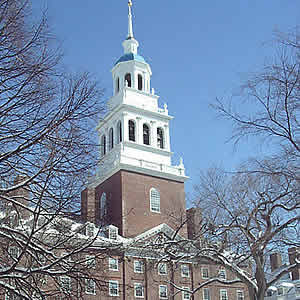Return to Harvard-Danilov Table of Contents page.
Background: Harvard has a set of 18 Russian bells purchased from the Soviet government in 1930, one of only five complete, intact sets of pre-revolutionary Russian bells left in the world. They came from Moscow's oldest monastery, which is now also the Patriarch's residence. The monastery has been trying to get the bells back for the past 20 years, but they have become part of Harvard's culture too, and the university is not just hoping to get rid of them. Also, the towers would have to be dismantled in order to remove them. Nonetheless, the dialogue has been amicable, and Harvard is willing to entertain the idea of their return.

December 10, 2002
Russians Seek Lowell Bells
Monastery sold bells in 1930, wants their return
Contributing Writer
 |
|
Crimson/Christina Hung
Harvard's Lowell bell tower is home to a set of 17 Russian bells (one more, the largest, is across the river at the Business School), which are being sought by their original owner, the Danilov Monastery in Moscow. They have awakened Harvard students for 72 years. |
The Lowell House bells, whose tones resound for a quarter-hour each Sunday morning, may be claimed by an echo of their Russian past.
The bells came from the St. Danilov Monastery in Moscow, where officials miss their distinct sounds and are calling for their return after 72 years of Harvard possession. They’ve set a return deadline÷March 2003 at the latest, the 700th anniversary of St. Danilov’s death.
“The bells are beautiful. You can see why they consider them an important part of Russian history,” said Lowell House Master Diana L. Eck. “If it was a practical matter to remove them, it would be a good thing to do, but there are many issues involved.”
Lowell House representatives and officials from the University President’s office have been discussing the question of returning the bells, but Eck said they were “highly unlikely” to reach a decision before March. The decision, she said, would come from higher University administrators.
“This is no small feat,” she said. “It would be both time consuming and expensive, requiring substantial fundraising that is not in anyone’s budget right now.”
According to William H. Bossert ’59, Arnold professor of science and a former Lowell master, removing the bells from their perch in the Lowell tower would cost tens of millions of dollars and require more than a summer’s worth of renovations. “They presumably will pay for it,” he said. “Money could be raised and wouldn’t be the basis of the decision.”
“Lowell would have to be closed for at least one semester, and a housing crisis would be too much of a problem,” he added.
But Eck said officials would need to conduct a structural engineering study and at the moment are “really not sure how it would impact housing.”
The bells, which were originally crafted for the monastery in the 17th and 18th centuries, were purchased from St. Danilov’s in the 1920s by industrialist Charles Crane when the Russian government threatened to melt them.
Crane, a Harvard graduate, then presented the 18 bells to University President A. Lawrence Lowell as a gift in 1930, the year that Lowell House was being built as part of the president’s new residential plan for the College.
Resident tutor Luis A. Campos ’99, a former House bell ringer, said the bells are physically beautiful, including “inscriptions, carvings and a beautiful green patina.”
“Any cultural artifact that has significance for two groups will create this kind of issue,” he said.
The bells have been rung almost constantly since the House was built and became such an important part of the House that in the 1950s students founded the Lowell House Society of Russian Bell Ringers, which still exists.
Although St. Danilov’s bell tower is not empty today and contains substitute bells, Father Roman Ugrinko, the current ringer, told the Moscow Times that “the bells have a weak sound, and they don’t play well together because they come from different churches. But to ring the original bells÷that would be a pleasure.”
This attempt to regain the bells is not the monastery’s first. When Bossert was master of Lowell in the late 1980s, the Archbishop of Moscow requested that Harvard return the bells.
“I looked into removing the bells or having a duplicate set made in the Netherlands,” he said, noting that a wealthy church in Long Island had been willing to cover the expenses.
Removing the bells would require dismantling the Lowell tower, which was originally planned as a clock tower modelled after Independence Hall in Philadelphia but was slightly redesigned and actually built around the bells.
Seventeen of the original 18 bells currently occupy the Lowell tower. The smallest measures the span of a hand, while the largest, named “Mother Earth,” weighs a full 13 tons.
The eighteenth bell, dubbed “Faith, Felicity and Harmony” by a Soviet bell specialist, was sent across the river to the Baker Library at the Harvard Business School.
Bossert said he proposed a compromise in the mid-1990s to return “Faith, Felicity and Harmony” to Russia as a gesture of understanding and as the first step in the possible future return of all the bells.
Eck said she imagined a similar scenario in which some of the smaller bells could be presented to St. Danilov’s as a “symbolic rendering” of Harvard’s concern and suggestive of returning the rest at some future point.
Most historians agree that if Crane had not purchased the bells, they would have been destroyed long ago by the Soviet regime.
“Harvard has not only done a good job of curating and preserving the bells, but also of allowing them to be seen,” Bossert said. “If the situation in Russia is not so stable and the bells are so revered, perhaps they are safer here.”
Return to the Harvard-Danilov Table of Contents page.